非谓语动词用法详解 动词的非谓语形式有三种
超详细非谓语动词讲解

超详细非谓语动词讲解非谓语动词是指在句中充当动词的成分,但不具备谓语的功能,主要有动词不定式、动名词和分词三种形式。
非谓语动词可以用于句法结构、修饰成分、语态和时态等方面的变化。
下面我将分别介绍这三种形式的非谓语动词。
一、动词不定式:动词不定式是由"to + 动词原形"构成的,可以用作动词、名词、形容词和副词的成分。
动词不定式的形式有时态和语态的变化。
1. 作为动词的补充:动词不定式可以作为及物动词的宾语或介词的宾语。
例句:- I want to go to the park.(作为动词want的宾语)- She agreed to help us.(作为介词to的宾语)2. 作为名词的补充:动词不定式可以作为句子成分的一部分,并起到名词的作用。
例句:- To study is important for children.(作为主语)- My goal is to become a doctor.(作为表语)3. 作为形容词的补充:动词不定式可以修饰名词或代词。
例句:- I have a book to read.(修饰名词book)- She needs someone to help her.(修饰代词someone)4. 作为副词的补充:动词不定式可以修饰动词、形容词或副词。
例句:- He came here to visit his parents.(修饰动词came)- The coffee is too hot to drink.(修饰形容词hot)二、动名词:动名词是由动词的现在分词形式构成的名词,具有名词的特点,可以作为主语、宾语、表语、定语和同位语等。
1. 作为主语:动名词可以作为句子的主语。
例句:- Dancing is her favorite hobby.2. 作为宾语:动名词可以作为及物动词的宾语。
例句:- He enjoys swimming in the sea.3. 作为表语:动名词可以作为系动词的表语。
非谓语动词三大形式
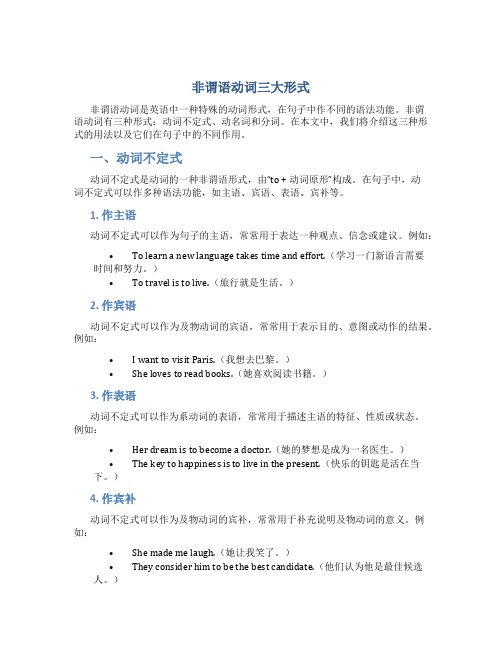
非谓语动词三大形式非谓语动词是英语中一种特殊的动词形式,在句子中作不同的语法功能。
非谓语动词有三种形式:动词不定式、动名词和分词。
在本文中,我们将介绍这三种形式的用法以及它们在句子中的不同作用。
一、动词不定式动词不定式是动词的一种非谓语形式,由“to + 动词原形”构成。
在句子中,动词不定式可以作多种语法功能,如主语、宾语、表语、宾补等。
1. 作主语动词不定式可以作为句子的主语,常常用于表达一种观点、信念或建议。
例如:•To learn a new language takes time and effort.(学习一门新语言需要时间和努力。
)•To travel is to live.(旅行就是生活。
)2. 作宾语动词不定式可以作为及物动词的宾语,常常用于表示目的、意图或动作的结果。
例如:•I want to visit Paris.(我想去巴黎。
)•She loves to read books.(她喜欢阅读书籍。
)3. 作表语动词不定式可以作为系动词的表语,常常用于描述主语的特征、性质或状态。
例如:•Her dream is to become a doctor.(她的梦想是成为一名医生。
)•The key to happiness is to live in the present.(快乐的钥匙是活在当下。
)4. 作宾补动词不定式可以作为及物动词的宾补,常常用于补充说明及物动词的意义。
例如:•She made me laugh.(她让我笑了。
)•They consider him to be the best candidate.(他们认为他是最佳候选人。
)二、动名词动名词是动词的一种非谓语形式,以-ing结尾。
在句子中,动名词可以作多种语法功能,如主语、宾语、表语、宾补等。
1. 作主语动名词可以作为句子的主语,常常用于表示一种习惯、经验或普遍情况。
例如:•Running helps to keep me fit.(跑步有助于保持健康。
非谓语动词的三种形式及用法区别

非谓语动词的三种形式及用法区别一、非谓语动词的三种形式:1. 动词-ing形式:动词-ing形式具有动名词的功能,一般用来表示一个正在进行或发生的动作,以及被动含义,等。
比如:He was observed walking along the street. 他被观察到沿着街道走。
2. 动词不定式形式:动词不定式具有名词、形容词和动词的功能,常用来表示目的、动机、结果、条件、时间、让步等。
比如:To face the danger bravely is his duty. 勇敢的去面对危险是他的责任。
3. 动词的过去分词形式:动词的过去分词常用来表示完成或发生过的动作或状态,以及主句的谓语动词的被动的形式,常用结构有:Be + done/past participle (被动),Have/Get + done(完成).比如:The machine is now ready to be used. 这台机器现在准备好被使用了。
二、非谓语动词的用法区别:1. 动词-ing形式:(1) 用作定语:形容词性短语作定语修饰名词或代词,如:He was aman working hard. 他是个努力工作的人。
(2) 用作表语:Ing 形式的短语作表语,表示一个正在进行的动作或状态,如:His job is repairing the machine. 他的工作是修理机器。
2. 动词不定式形式:(1) 作宾补:动词不定式作宾补表示“目的”,“动机”,“结果”,“条件”,“时间”,“让步”等。
如:He came here to do something for us. 他来这里为我们做一些事情。
(2) 作状语:动词不定式作状语,表示“目的”,“动机”,“条件”,“时间”,“让步”等。
如:She always goes out for a walk to relax herself. 她总是出去散步来放松自己。
非谓语动词三种形式

非谓语动词三种形式一、现在分词形式现在分词是动词的一种非谓语形式,通常由动词的原形加上-ing构成。
它可以作为主语、宾语、定语、状语等,表示与谓语动词同时或连续发生的动作或状态。
下面将分别从不同角度介绍现在分词的用法。
1. 作主语现在分词可以作为句子的主语,表示一个普遍、一般性的事实或状态。
例子:Running is good for your health.(跑步对健康有益)2. 作宾语现在分词可以作及物动词的宾语,表示被动的、连续进行的动作或状态。
例子:I enjoy reading books on weekends.(我喜欢在周末读书)3. 作定语现在分词可以作名词的前置定语,修饰名词。
例子:The crying baby woke up the whole neighborhood.(哭闹的婴儿把整个附近吵醒了)4. 作状语现在分词可以作状语,表示时间、原因、条件、结果等。
例子:Feeling tired, I decided to take a nap.(感到疲倦,我决定小睡一会儿)二、过去分词形式过去分词是动词的一种非谓语形式,通常由动词的原形加上-ed或不规则变化构成。
它可以作为表语、定语、状语、宾语等,表示被动、完成或状态。
下面将分别从不同角度介绍过去分词的用法。
1. 作表语过去分词可以作为系动词的表语,表示主语的特征或状态。
例子:The door was closed.(门是关着的)2. 作定语过去分词可以作名词的前置定语,修饰名词。
例子:The broken glass needs to be cleaned up.(破碎的玻璃需要清理)3. 作状语过去分词可以作状语,表示原因、条件、时间等。
例子:Having finished my homework, I went to bed early.(完成作业后,我早早就睡了)4. 作宾语过去分词可以作及物动词的宾语,表示被动或完成的动作。
非谓语动词的三种形式及用法讲解
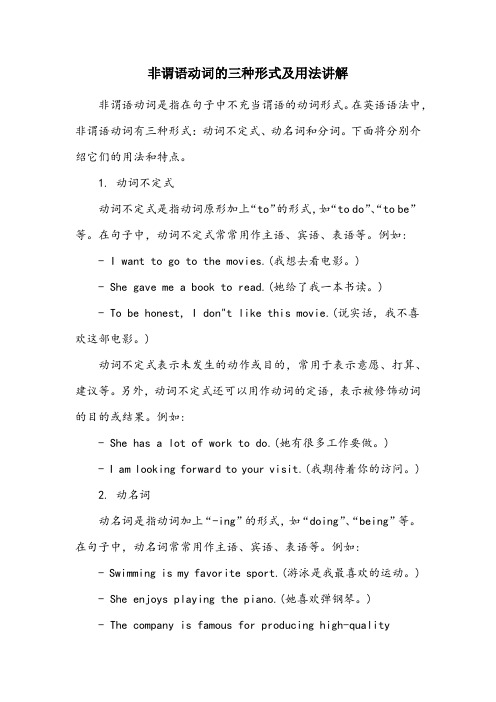
非谓语动词的三种形式及用法讲解非谓语动词是指在句子中不充当谓语的动词形式。
在英语语法中,非谓语动词有三种形式:动词不定式、动名词和分词。
下面将分别介绍它们的用法和特点。
1. 动词不定式动词不定式是指动词原形加上“to”的形式,如“to do”、“to be”等。
在句子中,动词不定式常常用作主语、宾语、表语等。
例如:- I want to go to the movies.(我想去看电影。
)- She gave me a book to read.(她给了我一本书读。
)- To be honest, I don"t like this movie.(说实话,我不喜欢这部电影。
)动词不定式表示未发生的动作或目的,常用于表示意愿、打算、建议等。
另外,动词不定式还可以用作动词的定语,表示被修饰动词的目的或结果。
例如:- She has a lot of work to do.(她有很多工作要做。
)- I am looking forward to your visit.(我期待着你的访问。
)2. 动名词动名词是指动词加上“-ing”的形式,如“doing”、“being”等。
在句子中,动名词常常用作主语、宾语、表语等。
例如:- Swimming is my favorite sport.(游泳是我最喜欢的运动。
) - She enjoys playing the piano.(她喜欢弹钢琴。
)- The company is famous for producing high-qualityproducts.(这家公司以生产高质量的产品而闻名。
)动名词表示正在进行的动作或状态,常用于表示爱好、兴趣、能力等。
另外,动名词还可以用作动词的定语,表示被修饰动词的方式或伴随状况。
例如:- I am feeling very tired.(我感觉很累。
)- She was excited about learning a new language.(她对学习一门新语言感到兴奋。
动词的非谓语形式有三种
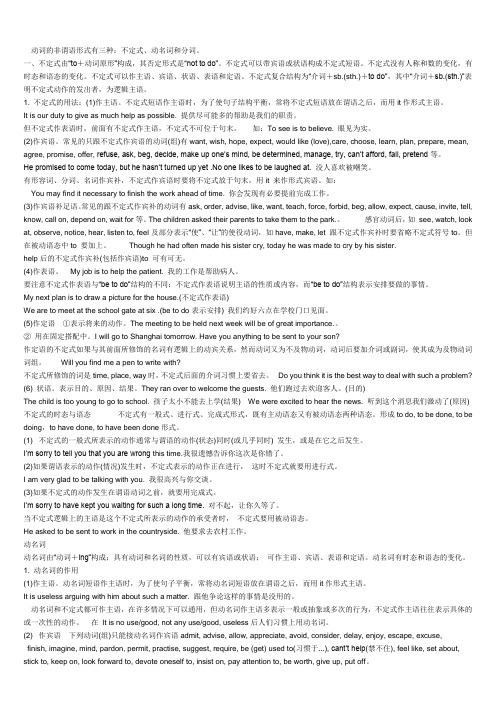
动词的非谓语形式有三种:不定式、动名词和分词。
一、不定式由“to+动词原形”构成,其否定形式是“not to do”。
不定式可以带宾语或状语构成不定式短语。
不定式没有人称和数的变化,有时态和语态的变化。
不定式可以作主语、宾语、状语、表语和定语。
不定式复合结构为“介词+sb.(sth.)+to do”,其中“介词+sb.(sth.)”表明不定式动作的发出者,为逻辑主语。
1. 不定式的用法:(1)作主语。
不定式短语作主语时,为了使句子结构平衡,常将不定式短语放在谓语之后,而用it作形式主语。
It is our duty to give as much help as possible. 提供尽可能多的帮助是我们的职责。
但不定式作表语时,前面有不定式作主语,不定式不可位于句末。
如:To see is to believe. 眼见为实。
(2)作宾语。
常见的只跟不定式作宾语的动词(组)有want, wish, hope, expect, would like (love),care, choose, learn, plan, prepare, mean, agree, promise, offer, refuse, ask, beg, decide, make up one’s mind, be determined, manage, try, can’t afford, fail, pretend等。
He promised to come today, but he hasn’t turned up yet .No one likes to be laughed at. 没人喜欢被嘲笑。
有形容词、分词、名词作宾补,不定式作宾语时要将不定式放于句末,用it 来作形式宾语。
如:You may find it necessary to finish the work ahead of time. 你会发现有必要提前完成工作。
非谓语动词的三种形式解析

非谓语动词的三种形式解析非谓语动词是指在句子中不担任谓语的动词形式,包括动词不定式、动名词和分词。
它们具有独立的语法作用,并能表达动作、状态或性质。
下面我们来详细解析非谓语动词的三种形式。
一、动词不定式动词不定式是动词的一种形式,通常由“to”加上动词原形构成。
动词不定式可以作为主语、宾语、表语、定语、状语等成分,具有时态和语态等变化。
1. 作主语:To learn a foreign language is beneficial for personal development.学习外语对个人发展有益。
2. 作宾语:The students want to visit the museum this weekend.这些学生想在这个周末参观博物馆。
3. 作表语:Her dream is to become a famous singer.她的梦想是成为一名著名歌手。
4. 作定语:I have a lot of books to read.我有很多书要读。
5. 作状语:He works hard to achieve his goals.他努力工作以实现他的目标。
二、动名词动名词是动词加上-ing构成的名词形式,具有名词的特点,可以担任主语、宾语、定语、表语等成分。
1. 作主语:Swimming is her favorite sport.游泳是她最喜欢的运动。
2. 作宾语:I enjoy playing the piano in my spare time.我喜欢在闲暇时间弹钢琴。
3. 作定语:The running water sounds very soothing.流水的声音听起来很舒缓。
4. 作表语:His hobby is collecting stamps.他的爱好是集邮。
三、分词分词是动词的一种形式,在句中可以作定语、状语等成分,常见的分词形式有现在分词(-ing形式)和过去分词(-ed、-en等形式)。
非谓语动词的用法详解

非谓语动词非谓语动词有3种:不定式,动名词和分词。
不定式不定式由“to do”构成,其否定式“not to do”。
不定式可带宾语或状语构成不定式短语,没有人称和数的变化,但有语态的变化,不定式可作主,宾,定,状,补,表,不能单独作谓语。
一. 不定式的用法1 作主语To see is to believe.It is right to give up smoking.2 作表语My job is to teach English.3 作宾语He wanted to go.I find it hard to work with him.常见用不定式作宾语的动词:want, wish, like, decide, help, ask, agree, afford, arrange, care, determine, fail, guarantee, hesitate, hope, hurry, manage, offer, pretend, promise, seek, prepare, refuse, swear, expec t, plan, would like, make up one’s mind, be determined4 作补语He asked me to open the door.常见用不定式作宾补的动词:advise, allow, permit, forbid, ask, beg, encourage, expect, force, get, invite, like, order, peruade, prefer, require, teach, tell, want, warn, wish, considerpractice:* 在感官动词feel, hear, listen to, see, look, notice, watch, observe,和使役动词make, let, have等后的补语中,不定式不带to,但这些句子变成被动结构时,就必须带toI often hear him sing the song.He is often heard to sing the song.5 作定语He is looking for a room to live in.There’s nothing to worry about.不定式作定语的用法:6 作状语I came here to see you. (表目的) in order to / so as toWe were excited to hear the news. (表原因)He hurried to the school (only) to find nobody there.(表结果7 疑问词+不定式,在句中起名词作用,可作主,宾,表He didn’t know what to say.How to solve the problem is very important.My question is when to start.8 作插入语To tell the truth, I don’t agree with you.to be sure to be frank to sum up to begin /start withto make matters worse to be brief二不定式的时态,语态1 一般式:表示的动作与谓语动作同时或在它之后发生He pretended not to know me when I met him in the street.2 进行式:表示动作发生时,不定式动作正在发生He pretended to be reading English when I entered the classroom.3 完成式:表示动作发生在谓语动作之前He is said to have learned English in Britain for a year.A railway is said to be being built now.No harm seems to have been done.四不定式的省略为避免重复可用to来代替前面的不定式,常出现在下列动词后expect, hope, wish, mean, prefer, care, forget, want, try 或出现在be glad, be happy, would like/love后eg: I haven’t been to Hong Kong, but I wish to.--- Would you come to the party?--- I’d love to, but…如果在省略不定式中含有be, have, have been 等系动词或助动词,这些词要保留。
动词的非谓语形式有三种

动词的非谓语形式有三种动词的非谓语形式有三种:不定式、动名词和分词(一)不定式不定式由“ to十动词原形”构成,其否定形式是“ not to do”.不定式可以带宾语或状语构成不定式短语,没有人称和数的变化,但有时态和语态的变化.不定式可作主语、宾语、状语、表语和定语,但不能单独作谓语.不定式的逻辑主语有时用“ for十名词或代词宾格”构成.1.不定式的用法:l)作主语.不定式短语作主语时,往往放在谓语之后,用it作形式主语.例如:To see is to believe.It is right to give up smoking.2)作宾语.不定式短语作宾语时,如果还带有宾语补足语。
往往把不定式宾语放在宾语补足语之后,而用it作形式宾语.例如:He wanted to go.I find it interesting to study work with him.3)作宾语补足语.例如:He asked me to do the work with him.注意:在feel,hear,listen to,look at,notice, observe,see,watch,have, let,make等词后的补足语中,不定式不带to.但是这些句子如果变成被动结构时,就必须带to.例如I often hear him sing the song.He is often heard to sing the song.注意:不定式动词在介词but,except,besides后面时,如果这些介词之前有行为动词do的各种形式,那么,这些介词后的不定式不带to,否则要带to.如:She could do nothing but cry.What do you like to do besides swim?I have no choice but to go.4)作定语.例如:I have some books for you to read.注①作定语的不定式如果是不及物动词,或者不定式所修饰的名词或代词是不定式动作的地点、工具等,不定式后面须有相应的介词.例如:He is looking for a room to live in.There is nothing to worry about.Please give me a knife to cut with.但是,不定式所修饰的名词如果是time,place或way,不定式后面的介词习惯上要省去.例如:He had no money and no place to live.注②当作定语的不定式所修饰的名词或代词是不定式动作的承受者时,不定式既可以用主动语态,也可用被动语态,但其含义有所不同.试比较:A) Have you anything to send? 你有什么东西要寄吗?(不定式to send的动作执行者是you)B) Have you anything to be sent? 你有什么要(我或别人)寄的东西吗?(不定式to be sent的动作执行者是已被省略的me 或someone else)5)作状语,表示目的、原因、结果或条件.例如:I came here to see you.(目的)We were very excited to hear the news.(原因)He hurried to the school to find nobody there.(结果)To look at him, you would like him.(条件)目的状语还可以用in order to或so as to来表示.如:In order to pass the exam, he worked very hard.We ran all the way so as not to be late.不定式也可在作表语用的形容词后面作状语.例如:I am very glad to hear it.The question is difficult to answer.“ too十形容词或副词十不定式”作状语.例如:He is too old to do that.另外句子中有enough这个词时,常用不定式作状语.例如:The room is big enough to hold us.6)作表语.例如:My job is to help the patient.7)作独立成分.例如:To tell the truth,I don’t agree with you.8)不定式与疑问词who,which,when,where,how,what等连用,在句中起名词作用,可充当主语、表语、宾语等.例如:He didn’t know what to say.(宾语)How to solve the problem is very important.(主语)My question is when to start. (表语)注意:在与why连用时,只用于why或why not开头的简短疑问句中,后面紧跟的动词不定式不带to. 例如:Why not have a rest?9)不定式在句中用主动式还是被动式。
高中英语语法 ―― 非谓语动词讲解
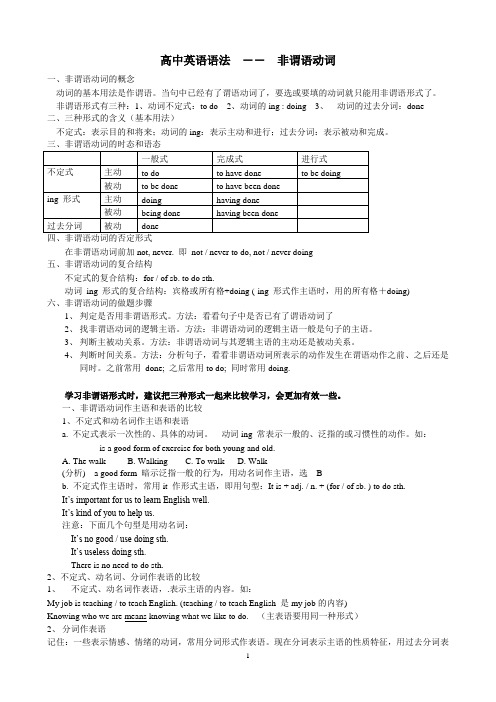
高中英语语法――非谓语动词一、非谓语动词的概念动词的基本用法是作谓语。
当句中已经有了谓语动词了,要选或要填的动词就只能用非谓语形式了。
非谓语形式有三种:1、动词不定式:to do 2、动词的ing : doing 3、动词的过去分词:done二、三种形式的含义(基本用法)不定式:表示目的和将来;动词的ing:表示主动和进行;过去分词:表示被动和完成。
在非谓语动词前加not, never. 即not / never to do, not / never doing五、非谓语动词的复合结构不定式的复合结构:for / of sb. to do sth.动词ing 形式的复合结构:宾格或所有格+doing (-ing 形式作主语时,用的所有格+doing)六、非谓语动词的做题步骤1、判定是否用非谓语形式。
方法:看看句子中是否已有了谓语动词了2、找非谓语动词的逻辑主语。
方法:非谓语动词的逻辑主语一般是句子的主语。
3、判断主被动关系。
方法:非谓语动词与其逻辑主语的主动还是被动关系。
4、判断时间关系。
方法:分析句子,看看非谓语动词所表示的动作发生在谓语动作之前、之后还是同时。
之前常用done; 之后常用to do; 同时常用doing.学习非谓语形式时,建议把三种形式一起来比较学习,会更加有效一些。
一、非谓语动词作主语和表语的比较1、不定式和动名词作主语和表语a. 不定式表示一次性的、具体的动词。
动词ing 常表示一般的、泛指的或习惯性的动作。
如:________ is a good form of exercise for both young and old.A. The walkB. WalkingC. To walkD. Walk(分析) a good form 暗示泛指一般的行为,用动名词作主语,选 Bb. 不定式作主语时,常用it 作形式主语,即用句型:It is + adj. / n. + (for / of sb. ) to do sth.It’s important for us to learn English well.It’s kind of you to help us.注意:下面几个句型是用动名词:It’s no good / use doing sth.It’s useless doing sth.There is no need to do sth.2、不定式、动名词、分词作表语的比较1、不定式、动名词作表语,.表示主语的内容。
非谓语动词的三种形式

非谓语动词共分为三种,构成形式如下:1.动词不定式(Infinitives):2.现在分词和过去分词(present participles & past participles):3. 动名词(gerunds)下面我们依据句子的成分,来具体分析非谓语动词的不同用法。
1.非谓语动词做主语和表语主语、表语和同位语在句子中用名词来担当,非谓语动词中动词不定式和动名词均可以用作名词,因此,动词不定式和动名词可以用来担当这三种成分。
1)非谓语动词做主语一般情况下,用动名词来做主语的情况比拟多,动词不定式用作主语的情况比拟少。
通常来说,在表达将来的要发生的事情时用不定式来作主语,而表达一般情况习惯性的动作时用动名词来作主语。
例如:Teaching is a tiring but satisfying job.Swimming is a good kind of e*ercise.To be an astronaut is Johnson’s desire.在用it做形式主语的句子中通常用动词不定式来做真正的主语。
例如:It is necessary (for you) to give up smoking.It is everyone’s duty to protect the environment.但是值得注意的是在各别情况下,即使是It做形式主语,真正的主语也必须用动名词,这些情况很少,所以希望同学们能单独记忆下来,以下是此类情况的一个总结。
It is/was no use/good doing sth.It is/was not any use/good doing sth.It is/was of little use/good doing sth.2)非谓语动词做表语非谓语动词作此成分的时候跟作主语时的规则根本一致。
在表示"目的,愿望,梦想,需求〞等名词做主语时其表语应该用不定式.例如:Her wish was to bee an artist.她的愿望是成为一位艺术家Our aim is to help them,not to teach them a lesson.我们的目的是帮助他们,而不是教训他们。
英语非谓语
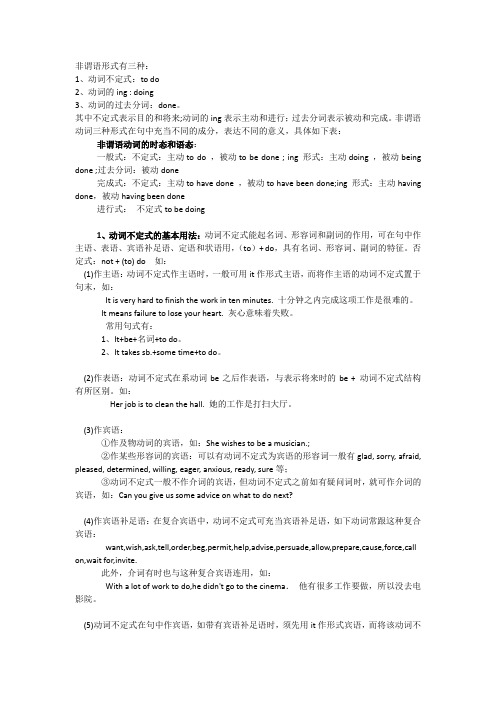
非谓语形式有三种:1、动词不定式:to do2、动词的ing : doing3、动词的过去分词:done。
其中不定式表示目的和将来;动词的ing表示主动和进行;过去分词表示被动和完成。
非谓语动词三种形式在句中充当不同的成分,表达不同的意义,具体如下表:非谓语动词的时态和语态:一般式:不定式:主动to do ,被动to be done ; ing 形式:主动doing ,被动being done ;过去分词:被动done完成式:不定式:主动to have done ,被动to have been done;ing 形式:主动having done,被动having been done进行式:不定式to be doing1、动词不定式的基本用法:动词不定式能起名词、形容词和副词的作用,可在句中作主语、表语、宾语补足语、定语和状语用,(to)+ do,具有名词、形容词、副词的特征。
否定式:not + (to) do 如:(1)作主语:动词不定式作主语时,一般可用it作形式主语,而将作主语的动词不定式置于句末,如:It is very hard to finish the work in ten minutes. 十分钟之内完成这项工作是很难的。
It means failure to lose your heart. 灰心意味着失败。
常用句式有:1、It+be+名词+to do。
2、It takes sb.+some time+to do。
(2)作表语:动词不定式在系动词be之后作表语,与表示将来时的be + 动词不定式结构有所区别。
如:Her job is to clean the hall. 她的工作是打扫大厅。
(3)作宾语:①作及物动词的宾语,如:She wishes to be a musician.;②作某些形容词的宾语:可以有动词不定式为宾语的形容词一般有glad, sorry, afraid, pleased, determined, willing, eager, anxious, ready, sure等;③动词不定式一般不作介词的宾语,但动词不定式之前如有疑问词时,就可作介词的宾语,如:Can you give us some advice on what to do next?(4)作宾语补足语:在复合宾语中,动词不定式可充当宾语补足语,如下动词常跟这种复合宾语:want,wish,ask,tell,order,beg,permit,help,advise,persuade,allow,prepare,cause,force,call on,wait for,invite.此外,介词有时也与这种复合宾语连用,如:With a lot of work to do,he didn't go to the cinema.他有很多工作要做,所以没去电影院。
非谓语动词的三种形式与用法

非谓语动词的三种形式与用法非谓语动词是指在句子中充当其他成分而不担任谓语的动词形式。
一般来说,非谓语动词有三种形式:不定式、动名词和分词。
它们在句子中有着不同的用法和功能。
下面将详细介绍这三种非谓语动词的形式与用法。
一、不定式不定式是动词的一种形式,它可以作为名词、形容词或副词的补语,也可以作为谓语的补语。
不定式一般由“to + 动词原形”构成。
1. 作为名词的补语不定式可以作为名词的补语,起到与名词相同的作用。
例如:- My dream is to travel around the world.(我的梦想是环游世界。
)- I have a lot of work to do.(我有很多事情要做。
)2. 作为形容词的补语不定式可以作为形容词的补语,修饰名词或代词。
例如:- She has a book to read.(她有一本要读的书。
)- I am happy to see you.(见到你我很高兴。
)3. 作为副词的补语不定式可以作为副词的补语,修饰动词、形容词或副词。
例如:- He ran fast to catch the bus.(他快速地跑去赶公交车。
)- I woke up early to prepare for the exam.(我早早醒来准备考试。
)二、动名词动名词是一种以-ing 结尾的动词形式,它可以作为名词的主语、宾语、定语、表语等。
1. 作为名词的主语动名词可以作为句子的主语,表示某种行为或概念。
例如:- Swimming is good exercise.(游泳是一项好的锻炼。
)- Reading books is my favorite hobby.(阅读书籍是我最喜欢的爱好。
)2. 作为名词的宾语动名词可以作为某些动词的宾语,表示被动或完成的动作。
例如:- I enjoy swimming in the sea.(我喜欢在海里游泳。
)- She hates doing household chores.(她讨厌做家务活。
非谓语动词典型例句

非谓语动词典型例句
动词的非谓语形式有三种:
1.不定式(The Infinitive),由to +动词原形构成,to 为不定式符号,并无实际意义。
2.动名词(The Gerund),由动词+ing构成。
3.分词(The Participle)
1)现在分词(The Present Participle),由动词+ing构成
2)过去分词(The Past Participle),由动词+ed构成。
非谓语动词具有以下特征:
非谓语动词可以做主语、宾语等多种句子成分,但唯独不能做谓语。
非谓语动词具有各种形态:原形、主动语态、被动语态、进行时态和完成时态。
非谓语动词具有动词的功能,如可以有自己的宾语,但不具有语法上的动词性质,如没有人称和数的变化。
使用非谓语动词的条件:
在一个句子中,已经存在一个谓语动词,而又没有连词的情况下,其他的动词就需要使用非谓语形式。
非谓语动词典型例句:
Growing flowers is my hobby.
Thank you for helping us.
I hope to see you again.
He wanted to see you.
It is an honor for me to be asked to speak here.
The book is said to have been translated into English.
He is proud of having been sent to work in Tibet .
He remembered being taken to Beijing when he was a child.。
非谓语动词的构成及其用法

不定式、动名词作宾语
• He chose not to go home this weekend. • The manager desires to see you. • My mother dislikes seeing you with me. • He could hardly resist laughing. • He is fond of playing tennis. • 动名词既可做动词宾语,也可做介词的宾语,而不定式只能做动词宾
4. Nobody is willing to go to a party without _____C______.
A. asking
B. to be asked
C. being asked
D. having asked
非谓语动词做宾语补足语
可以接不定式做宾语补足语的动词常用的有: ask, want, advise, allow, encourage, force,forbid,like, order, permit, persuade, request, require, tell, warn, urge, expect 这些词后均可接+sb. to do sth.的结构 Father will not allow us to play on the street. My teacher advised me to do more exercises.
➢ be/get used to, devote oneself to, ➢ look forward to, object to, prefer...to, ➢ refer to, pay attention to, stick to, lead to
这些词组里的to为介词,而非不定式符号。
三种非谓语的区别
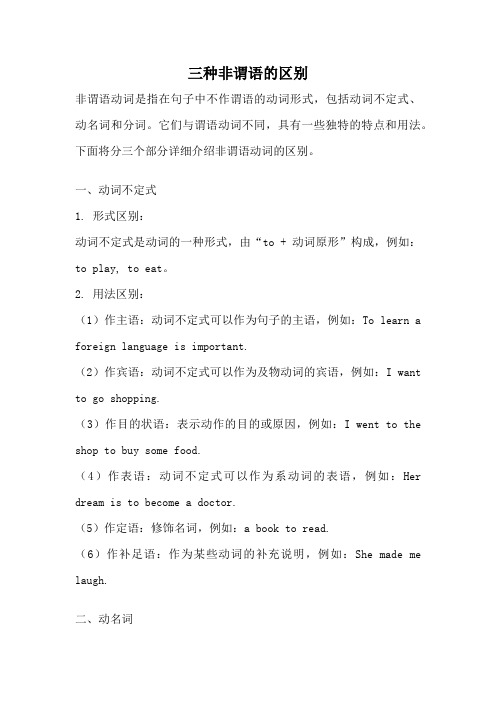
三种非谓语的区别非谓语动词是指在句子中不作谓语的动词形式,包括动词不定式、动名词和分词。
它们与谓语动词不同,具有一些独特的特点和用法。
下面将分三个部分详细介绍非谓语动词的区别。
一、动词不定式1. 形式区别:动词不定式是动词的一种形式,由“to + 动词原形”构成,例如:to play, to eat。
2. 用法区别:(1)作主语:动词不定式可以作为句子的主语,例如:To learn a foreign language is important.(2)作宾语:动词不定式可以作为及物动词的宾语,例如:I want to go shopping.(3)作目的状语:表示动作的目的或原因,例如:I went to the shop to buy some food.(4)作表语:动词不定式可以作为系动词的表语,例如:Her dream is to become a doctor.(5)作定语:修饰名词,例如:a book to read.(6)作补足语:作为某些动词的补充说明,例如:She made me laugh.二、动名词1. 形式区别:动名词是动词的一种形式,以-ing结尾,例如:playing, eating。
2. 用法区别:(1)作主语:动名词可以作为句子的主语,例如:Swimming is good for health.(2)作宾语:动名词可以作为及物动词的宾语,例如:I enjoy swimming.(3)作目的状语:表示动作的目的或原因,例如:I went swimming to relax.(4)作定语:修饰名词,例如:a running dog.(5)作表语:动名词可以作为系动词的表语,例如:His hobby is playing basketball.(6)作宾语补足语:作为某些动词的补充说明,例如:She saw him dancing.三、分词1. 形式区别:分词是动词的一种形式,分为现在分词和过去分词两种形式,例如:playing, eaten。
动词的非谓语形式及其用法

动词的非谓语形式及其用法动词是语言中的重要成分之一,它负责表达行为、状态或存在。
除了谓语形式之外,在语法中还存在一些非谓语形式,它们在句子中扮演着不同的角色。
本文将介绍几种常见的非谓语形式,并探讨它们的用法。
一、动词的非谓语形式1. 不定式(Infinitive)不定式是动词的一种非谓语形式,一般由to加上动词原形构成。
不定式可以作为名词、形容词或副词的补语,也可以用作动词的宾语、主语或表语等。
例句:- My dream is to travel around the world.(作为名词的补语)- She is eager to learn new things.(作为形容词的补语)- He wants to buy a new car.(作为动词的宾语)2. 动名词(Gerund)动名词是以-ing结尾的动词形式,它可以作为名词的主语、宾语、表语等,也可以放在介词后面做宾语。
例句:- Swimming is good for your health.(作为名词的主语)- I enjoy playing basketball in my free time.(作为名词的宾语)- She is good at singing.(作为名词的表语)3. 分词(Participle)分词是动词的一种非谓语形式,分为现在分词(-ing结尾)和过去分词(-ed、-en、-d、-t结尾)。
分词可以作为形容词、状语等。
例句:- The running water sounds very relaxing.(现在分词作为形容词)- The broken mirror needs to be replaced.(过去分词作为形容词)- Raised in a small town, she is used to the quiet life.(现在分词作为状语)二、非谓语形式的用法1. 作宾语动词的非谓语形式可以用作及物动词的宾语。
- 1、下载文档前请自行甄别文档内容的完整性,平台不提供额外的编辑、内容补充、找答案等附加服务。
- 2、"仅部分预览"的文档,不可在线预览部分如存在完整性等问题,可反馈申请退款(可完整预览的文档不适用该条件!)。
- 3、如文档侵犯您的权益,请联系客服反馈,我们会尽快为您处理(人工客服工作时间:9:00-18:30)。
非谓语动词用法详解动词的非谓语形式有三种:不定式、动名词和分词(一)不定式不定式由“ to十动词原形”构成,其否定形式是“ not to do”.不定式可以带宾语或状语构成不定式短语,没有人称和数的变化,但有时态和语态的变化.不定式可作主语、宾语、状语、表语和定语,但不能单独作谓语.不定式的逻辑主语有时用“ for十名词或代词宾格”构成. 1.不定式的用法: l)作主语.不定式短语作主语时,往往放在谓语之后,用it作形式主语.例如: To se e is to believe. It is right to give up smoking. 2)作宾语.不定式短语作宾语时,如果还带有宾语补足语。
往往把不定式宾语放在宾语补足语之后,而用it作形式宾语.例如: He wanted to go. I find it interesting to study work with him. 3)作宾语补足语.例如: He asked me to do the work with him. 注意:在feel,hear,listen to,look at,notice, observe,see,watch,have, let,make等词后的补足语中,不定式不带to.但是这些句子如果变成被动结构时,就必须带to.例如I often hear him sing the song. He is often heard to sing the song. 注意:不定式动词在介词but,except,besides后面时,如果这些介词之前有行为动词do的各种形式,那么,这些介词后的不定式不带to,否则要带to.如: She could do nothing but cry. What do you like to do besides swim? I have n o choice but to go. 4)作定语.例如: I have some books for you to read. 注①作定语的不定式如果是不及物动词,或者不定式所修饰的名词或代词是不定式动作的地点、工具等,不定式后面须有相应的介词.例如: He is looking for a room to live in. There is nothin g to worry about. Please give me a knife to cut with. 但是,不定式所修饰的名词如果是time,place或way,不定式后面的介词习惯上要省去.例如: He had no money and no place to live. 注②当作定语的不定式所修饰的名词或代词是不定式动作的承受者时,不定式既可以用主动语态,也可用被动语态,但其含义有所不同.试比较: A) Have you an ything to send? 你有什么东西要寄吗? (不定式to send的动作执行者是you) B) Have you anything to be sent? 你有什么要(我或别人)寄的东西吗? (不定式to be sent的动作执行者是已被省略的me或someone else) 5)作状语,表示目的、原因、结果或条件.例如: I came here to see you.(目的) We were very excited to hear the news.(原因) He hurried to the school to find nobody there.(结果) To look at him, you would lik e him.(条件) 目的状语还可以用in order to或so as to来表示.如: In order to pass th e exam, he worked very hard. We ran all the way so as not to be late. 不定式也可在作表语用的形容词后面作状语.例如: I am very glad to hear it. The question is dif ficult to answer. “ too十形容词或副词十不定式”作状语.例如: He is too old to do that.另外句子中有enough这个词时,常用不定式作状语.例如: The room is big enough to hold us. 6)作表语.例如: My job is to help the patient. 7)作独立成分.例如: To tell the truth,I don’t agree with you. 8)不定式与疑问词who,which,when,where,how,what等连用,在句中起名词作用,可充当主语、表语、宾语等.例如: He didn’t know wha t to say.(宾语) How to solve the problem is very important.(主语) My question is w hen to start. (表语) 注意:在与why连用时,只用于why或why not开头的简短疑问句中,后面紧跟的动词不定式不带to. 例如: Why not have a rest? 9)不定式在句中用主动式还是被动式。
多数情况下是容易判别的,但有时的确比较复杂,请注意以下几点: A)不定式修饰的名词或代词和不定式构成逻辑上的主谓关系时,不定式往往用主动形式. Have you got a key to unlock the door? (A key unlocks the door.) B)不定式和它前面被修饰的名词或代词构成逻辑上的动宾关系,又和该句主语构成逻辑上的主谓关系时,不定式常用主动形式. I have got a letter to write.( I write letter.) He needs a room to live in.( He lives in a room.) I know what to do.( I do what.) 但这句如改为下列形式,不定式就得用被动形式: I know what is to be done. 这是因为what is to be done是宾语从句,从句中的主语what是动词do的动作对象C)不定式作表语形容词的状语,和句中主语构成逻辑上的动宾关系时,不定式多用主动形式,这是因为人们往往认为形容词后省去了for one或for people.例如: He is hard to talk to.( to talk to him.) The book is diffi cult to understand. ( to understand the book.) 但如果强调句中的受事者时,亦可用不定式被动式,例如: The handwriting is very difficult to be read. The box is too heavy to be lifted. D)在“there十be” 的结构中,当说话人考虑的是必须有人去完成某件事时,不定式用主动形式,如果说话人强调的是事情本身必须完成,则用被动形式. There is a lot of work to do. ( Somebody has to do the work.) There is a lot of work to be d one. ( The work has to be done.) 请注意下面两个句子的含义是不同的: There is not hing to do. 意为无事可做,感到十分乏味. There is nothing to be done.意为某东西坏了,无法使之恢复正常. 2.不定式的时态l)不定式的一般形式所表示的动作,通常与谓语的动作(状态)同时(或几乎同时)发生,或是在它之后发生.例如: I saw him go out. 2)如果谓语表示的动作(情况)发生时,不定式表示的动作正在进行,这时不定式就要用进行式.例如: I am very glad to be working with you. 3)如果不定式的动作发生在谓语动词之前,就要用完成式.例如: I’m sorry to have kept you waiting. 3.不定式的语态当不定式逻辑上的主语是这个不定式所表示的动作的承受者时,不定式一般要用被动形式。
例如: He asked to be sent to work in the countryside. It is possible for our hopes to be realized. (二)动名词1.动名词由动词+ ing构成;具有动词和名词的性质;在句中起名词作用,可作主语、宾语、表语和定语. 1)作主语.例如: Seeing is believing. Laying eggs is the ant queen’s full- time job. It is no use arguing with him. 注意:动名词和不定式都可以作主语,动名词作主语表示一般或抽象的多次性行为,不定式作主语往往表示具体的或一次性的动作.例如: Playing with fire is dangerous.(泛指玩火) To play with fire will be dangerous. (指一具体动作) 但在It is no use/ good,not any use/ good,useless等后必需用动名词。
2)作表语.例如: Her job is teaching. 3)作宾语.例如: He is fond of playing footbal l. I like swimming. 注①admit,appreciate,avoid,consider, delay, dislike,enjoy,e scape, excuse,face,feel. like,finish,forgive,give up, imagine,include,keep,m ention,mind,miss,practise,put off,resist, risk,suggest,can’t help,can’t stand(无法忍受)等动词后可以用动名词作宾语,但不能用不定式. 注②forget,go on,like,mea n,regret,remember,stop,try等动词可带动名词或不定式作宾语,但意义上有区别。
I remember doing the exercise. (我记得做过练习.) I must remember to do it. (我必须记着做这事.) I tried not to go there.(我没法不去那里.) I tried doing it again. (我试着又干了一次.) Stop speaking. (不要讲话。
